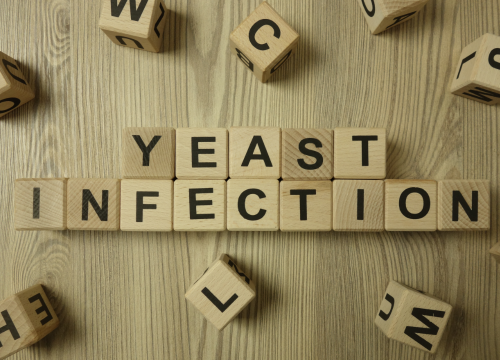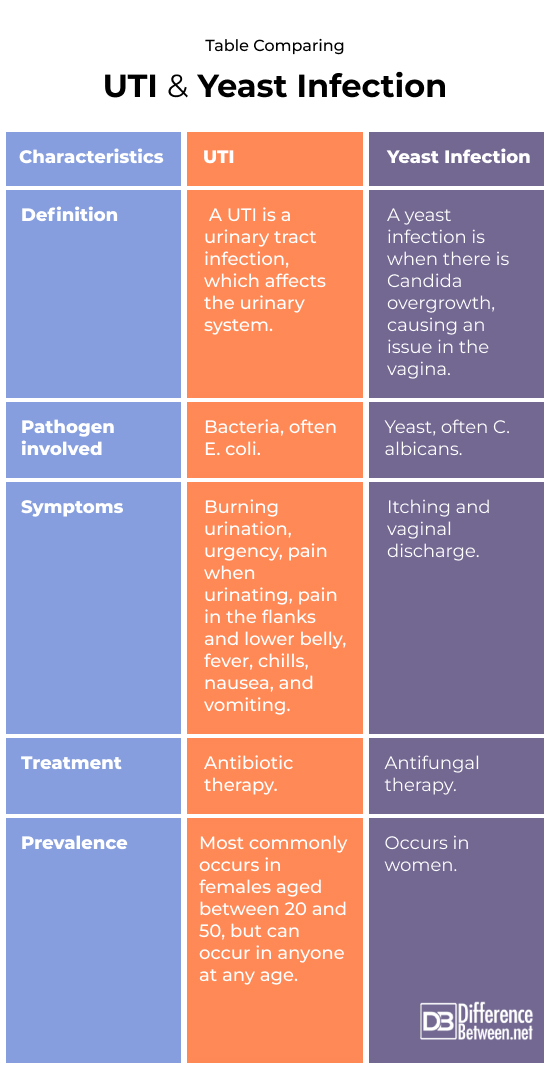Difference Between UTI and Yeast Infection
A UTI is a urinary tract infection which affects the bladder, ureters, or kidneys. A UTI is unpleasant and can cause problems with the kidneys. A yeast infection is where there is an overgrowth of Candida yeast in the vagina. While a UTI causes painful urination and causes you to need to urinate often, a yeast infection causes itching and a white vaginal discharge. While the yeast that causes vaginal infections is a type of fungus, the UTIs are usually caused by bacteria. It is unusual for Candida to cause UTIs but this may happen in people with a compromised immune system, and those who have medical problems like diabetes.
UTIs can be treated using antibiotic therapy, but this can actually increase the chances of developing a yeast infection since it alters the natural microbiome of the person. Yeast infections can be treated using various antifungal creams.
In short, UTIs are usually bacterial infections that affect the urinary system of the body, while yeast infections affect the vagina and are caused by Candida yeast.

What is UTI?
Definition:
A UTI is defined as an infection of the urinary tract, which includes the bladder, ureters, and kidneys. The UTI may only affect the bladder, in which case it is known as cystitis. When the UTI affect the kidneys, it is known as pyelonephritis. The most common cause of UTIs is the E. coli bacteria. This bacterial species occurs in the gut and can infect the bladder and kidneys at times. A UTI is more common in females than males because the urethra of females is shorter, making transmission of the bacteria from anus to urethra more likely.
Symptoms and treatment:
A UTI can cause frequent urination, burning when urinating, a sense of urgency in needing to urinate, pain in the sides up under the ribs, and pain in the lower part of the abdomen. If you have pyelonephritis, you can become very ill and experience nausea and vomiting, along with pain under the ribs, and frequent urination. You may also have chills and a fever. Urine may also be frothy-looking; white blood cells, and protein may be detected in a urine test. A kidney stone causing a blockage can sometimes also increase the odds of infection in the kidneys.

What is Yeast Infection?
Definition:
A yeast infection is most commonly an infection of the vagina with Candida albicans. While the yeast can affect other mucous membranes of the body, it is less common. A vaginal yeast infection can be diagnosed by a physical exam, but a culture can be taken and viewed under a microscope. Microscopic examination can show the presence of fungal hyphae of Candida. The yeast is part of the natural microbiome in the human body, and only causes a problem when there is an overgrowth. This is sometimes due to antibiotic use where the natural microbiome has been disrupted.
Symptoms and treatment:
The main symptom of a yeast infection is itching. There may be some burning and redness of the vulva. The yeast also produces a white, cottage-cheese like discharge to be produced from the vagina. Antifungal medications are usually used to get the yeast under control. Fluconazole can be given as oral medication and there are also antifungal suppositories that the doctor may recommend, such as miconazole.
Difference between UTI and Yeast Infection?
Definition
A UTI is a urinary tract infection, which affects some or all of the urinary system. A yeast infection is when there is Candida overgrowth, usually in the vagina.
Pathogen
Bacteria, usually E. coli, are the cause of UTIs. Yeast infections are caused by Candida albicans.
Symptoms
Burning urination, urgency, pain when urinating, pain in the flanks and lower belly, fever, chills, and nausea are all signs of a UTI. A yeast infection presents with signs like vulva itching and vaginal discharge.
Treatment
A UTI is treated with antibiotic medicines. A yeast infection can be treated with antifungals, either as suppositories, or oral medicines.
Prevalence
UTIs are most common in women between 20 and 50. Yeast infections are common in females, especially older women.
Table comparing UTI and Yeast Infection

Summary of UTI Vs. Yeast Infection
- A UTI typically causes burning when urinating and pain in the lower abdomen, back, or flanks.
- A yeast infection causes itching and swelling in the vulva.
- Antifungals are used to treat yeast infections while antibiotics are used to treat UTIs.
FAQ
How do I know if I have a UTI or yeast infection?
There may be burning when urinating if you have a UTI, but a yeast infection causes itching and discharge.
Can a yeast infection make you feel like you have to pee?
Yeast infections can sometimes cause you to feel like you need to pee. This is, however, more commonly the case with UTIs.
Can you tell if you have a yeast infection with urine?
A doctor can usually easily tell you have a yeast infection by doing a physical exam and noting the presence of yeast in the vagina. There may be small amounts of yeast in the urine as well.
How does UTI discharge look like?
Discharge from a UTI will contain pus and mucus, and be foul-smelling.
Can you flush out a UTI with water?
Drinking lots of water can help flush out the bacteria causing a UTI, but it is always best to consult a doctor who may need to prescribe antibiotics.
What are the 5 warning signs of bladder infection?
Five warning signs of a bladder infection include urine that smells worse than usual, feeling a strong need to urinate and urinating often, a pain that is dull and does not go away, and feeling ill.
Can drinking a lot of water flush out a yeast infection?
Increasing your water intake can help to flush out yeast but you may still need to see a doctor if you find that the problem persists or worsens.
What color is your pee if you have a yeast infection?
The urine may be less clear than normal, but this may depend on how severe your condition is.
How to get rid of a yeast infection in 24 hours without meds?
You can use over-the-counter antifungal treatments that can quickly clear a yeast infection. However, severe infections may need additional treatment.
- Difference Between Rumination and Regurgitation - June 13, 2024
- Difference Between Pyelectasis and Hydronephrosis - June 4, 2024
- Difference Between Cellulitis and Erysipelas - June 1, 2024
Search DifferenceBetween.net :
5 Comments
Leave a Response
References :
[0]Goje, Oluwatosin. “Candidal Vaginitis”. Merckmanuals. Merck & Co., 2023, https://www.msdmanuals.com/professional/gynecology-and-obstetrics/vaginitis,-cervicitis,-and-pelvic-inflammatory-disease/candidal-vaginitis
[1]Imam, Talha H. “Bacterial Urinary Tract Infections”. Merckmanuals. Merck & Co., 2024, https://www.msdmanuals.com/professional/genitourinary-disorders/urinary-tract-infections-utis/bacterial-urinary-tract-infections
[2]Imam, Talha H. “Introduction to Urinary Tract Infections (UTIs)”. Merckmanuals. Merck & Co., 2024, https://www.msdmanuals.com/professional/genitourinary-disorders/urinary-tract-infections-utis/introduction-to-urinary-tract-infections-utis
[3]Image credit: https://www.canva.com/photos/MAEFbWOW7Io-uti-acronym-from-wooden-blocks-with-letters-abbreviation-uti-urinary-tract-infection-concept-yellow-background-with-stethoscope/
[4]Image credit: https://www.canva.com/photos/MADsYURvd8I-text-yeast-infection-from-wooden-blocks/

My yeast infection problems almost always resulted in a bladder infection and digestive problems. It seemed inevitable, season after season. I would start to feel really tired and have abominable cramps. Then I would go to the doctor and have an examination. The yeast infection would be the first on the list and the other symptoms would be treated separately – prescription for antibiotics for the bladder infection and antacids for the pain in my stomach and gas.
I now know why I was getting the UTI infections – the yeast kept the opening to the bladder swollen and slightly open for bacteria to enter. After I learned to keep the yeast under control, I have not had the UTIs.
Helpful comment.
How do you keep the yeast under control?
Thanks for ur article. The symptoms of yeast infection are many and they can mirror many other illnesses. Thus, you should confirm with your doctor to make sure that your problem is really it.
How do you keep yeast under control.